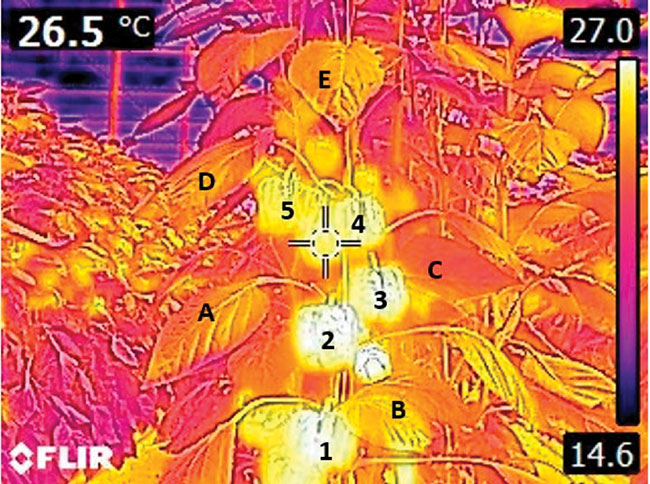
Features
Vegetables
The heat in sweet peppers
Infrared cameras could help gain insight into crop health.
June 30, 2020 By Charlotte Coates and Dr. Peter Kevan
 Figure 1. An infrared false colour image captures the temperature of developing sweet green peppers at a DelFresco Pure greenhouse in Kingsville, Ont. Fruits are numbered 1 to 5, leaves are labelled A to E. The scale on the right shows the range in temperature.
Photo credit: C. Coates
Figure 1. An infrared false colour image captures the temperature of developing sweet green peppers at a DelFresco Pure greenhouse in Kingsville, Ont. Fruits are numbered 1 to 5, leaves are labelled A to E. The scale on the right shows the range in temperature.
Photo credit: C. Coates Just as human beings have different skin temperatures of distinct parts of the body, the surface temperatures of plants and parts of plants tell us a lot about how they function.
Using infrared thermometry with false colour imagery, we observed the surface temperatures of various parts of the sweet pepper crop in the shady environment of a production greenhouse located in southwestern Ontario. Using a FLIR (Forward-Looking Infrared) camera, we observed that although these pepper fruits are sweet, they are hot in comparison to their leaves and stems and the surrounding air.
From Fig 1., the average temperature for all of the visibly developing peppers was 26.84 ˚C, which was 3.24 ˚C higher than the average leaf temperature at 23.6˚C. Similarly, the average minimum and maximum temperatures of the peppers were around three degrees higher than the average minimum and maximum temperatures of the leaves. Note that the daily greenhouse temperature was 20 ˚C, the pre-nighttime temperature was 11˚C and post-nighttime temperature was 14˚C.
Clearly, the additional heat of the fruits was not due to direct solar radiation because the leaves and stems were not reaching the same high temperatures. Moreover, the greenhouse was experiencing cloudy conditions when the observations were made. So why were the fruits hotter than the other plant parts? It could be that as fruits develop, they grow quickly and do not transpire as much, resulting in excess metabolic heat. Perhaps they were absorbing heat from the heating pipes, which had surface temperatures of 30.7˚C to 41.0˚C. The reason behind this phenomenon of higher temperature fruit remains unknown and is part of our ongoing research.
High surface temperatures of fruits are known to cause damage or “sunburn” that reduces the yield and quality of the fruit, regardless of whether the excess heat is from solar radiation or another source (McCaskill et al., 2016; Yazici & Kaynak, 2009). Much of the research conducted on fruit surface temperatures use thermocouplers to measure fruit temperature, but infrared and near infrared cameras can offer additional uses for horticulturalists and food producers.
Infrared and near-infrared spectrum technology has been used to characterize fruits for sugar and acid content and to assess plant pathogens (Salman & Abu-Khalaf, 2013). This non-invasive sensor technology has been used on a wide variety of agricultural plants to measure many parameters such as quality, stress and diseases. Going forward, we may see more producers using infrared cameras to gain insight into crop health and a deeper understanding of the life of plants, including bell peppers under greenhouse conditions.
Acknowledgements:
This project is part of the Accelerating Green Plant Innovation for Environmental and Economic Benefit Cluster and is funded by the Canadian Ornamental Horticulture Alliance (COHA-ACHO) and by the Government of Canada under the Canadian Agricultural Partnership’s AgriScience Program. We are grateful for the generous access to the production greenhouse at Sunrite Greenhouses Ltd. and DelFresco Produce Ltd. and their personnel, Muhammad Javed and Rashid Idrees. Shalin Khosla, former greenhouse vegetable specialist at the Ontario Ministry of Agriculture, Food and Rural Affairs, was instrumental in initiating this small project.
References:
- Abu-Khalaf, N., and Salman, M. (2013). Spectroscopy. NIR News. https://doi.org/10.1255/nirn.1369
- Jones, G. H. et al. (2003). Journal of Experimental Botany https://doi.org/10.1093/jxb/erg116
- McCaskill, M. R., et al. (2016). Agricultural and Forest Meteorology doi:10.1016/j.agrformet.2016.05.017
- Yazici, K. and Kaynak, L. (2009). Acta Horticulturae. doi: 10.17660/ActaHortic.2009.818.26
Charlotte Coates is a research associate, Peter Kevan is professor Emeritus at the University of Guelph.
Print this page